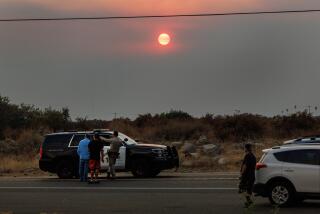A Last-Ditch Approach to Smog
The San Joaquin Valley is about to become the first region in the nation to voluntarily label its atmosphere extremely polluted, a move that buys more time for industry to cut smog but imposes a stigma the valley will bear for the remainder of the decade.
On Thursday, the San Joaquin Valley Air Pollution Control District board decided it will request the designation by Sept. 18, the latest possible opportunity to avoid financial penalties. It also ordered development of a new anti-smog plan to guide local, state and federal authorities on a path to clean air by 2010.
“It is an unprecedented action, a very serious action. It’s the first area in the country to have made this commitment,” said Amy Zimpfer, deputy director for air programs in the U.S. Environmental Protection Agency’s California office.
Threatened with the hammer of federal penalties, local air quality officials are confronted with a Hobson’s choice. “Business as usual” would guarantee economic sanctions, the penalty the Clean Air Act requires of places that don’t clean up on schedule.
The only way to avoid that is to buy time by asking the federal government to declare air over the 25,000-square-mile valley extremely polluted.
That’s a designation that until now applied only to the Los Angeles Basin’s filthy skies. Los Angeles was designated so polluted by the Clean Air Act.
The decision is the clearest signal yet that the valley’s anti-smog program is in serious trouble. Air quality officials missed a key 1999 ozone cleanup target and got a six-year extension last year.
Then they announced this spring that they could not meet the revised deadline and needed five extra years--and possibly more--before they could trim enough emissions to comply with even the most minimal federal standards.
The designation would broaden regulations to include food processors, small power plants and painting operations, which would be required to get pollution permits.
More facilities, in general, would be required to use the best available smog controls, while new and expanding businesses could be required to secure additional “offsets” from other polluters. Offsets are a type of credit that one polluter acquires from another to compensate for emissions.
Despite the prospect of more regulation, business leaders applauded the decision.
“We are very pleased with the board’s decision today. This will maintain local control and allow a collaborative approach. This is the best option we have,” said Suzanne Noble, an oil industry representative with the business-oriented San Joaquin Valley Air Quality Coalition.
However, environmentalists condemned air quality officials for a decision that would postpone by five years the date when the region must comply with federal smog standards.
“This is terrible news for everyone with respiratory problems in the Central Valley,” said Ann Harper, an attorney for the Earthjustice Legal Defense Fund, which has sued air quality agencies over valley smog.
“This foot-dragging shows what happens when regulators avoid difficult decisions for decades,” she said. “This shows how clearly the air district’s governing board members are in the pocket of the big agriculture and oil industries.”
But business groups said the local air quality agency had little choice. Without a change in the smog designation, the EPA was poised to cut off millions of dollars in federal highway funds, take over valley smog-control programs and impose measures to restrict economic expansion.
California’s heartland, long associated with sunshine and food crops, is today suffused with soot and gases. Pollution comes from farm equipment and oil refineries, clouds of dusty cow dung and auto tailpipes, diesel trucks and food processing plants.
What gains have been made pale in comparison to those achieved in major cities with far more people, cars and business. Blame lies with lax regulation, growth and a merciless climate that pushes pollution to smothering levels for many of the valley’s 2.5 million residents.
Air quality officials say at least 300 tons of smog-forming pollutants must be reduced daily to meet the federal ozone standard.
About half that will come from controls already approved for diesel engines beginning in 2006 and measures planned for industry.
More to Read
Sign up for Essential California
The most important California stories and recommendations in your inbox every morning.
You may occasionally receive promotional content from the Los Angeles Times.










